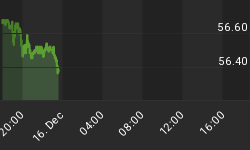The Monthly DJIA Coppock Curve has dropped below -125 into what I call "deep territory" 13 times since 1926, with the 13th occurrence coming on 10/31/02. This latest occurrence has not yet resolved itself, but the 12 earlier drops were all necessarily followed sooner or later by a deep or very deep Coppock buy signal. I define a deep signal as a turn up of at least 10 points from -125 or lower, while a very deep signal is a turn up of at least 10 points from -250 or lower.

Interestingly, 10 of those 12 earlier Coppock drops were associated with at least one instance of Peter Eliades' CI-NCI Ratio dipping to 0.9400 less than a year before the eventual deep or very deep Coppock buy signal. Only in 1941 and 1978 did that not happen. In the 10 cases where it did happen, the date the Ratio last reached 0.9400 to the downside preceded a deep or very deep Coppock buy signal by 15 trading days (8/31/32 very deep signal), 44 trading days (7/30/38 very deep signal), 142 trading days (9/30/42 deep signal), 171 trading days (8/29/47 deep signal), 91 trading days (1/31/63 deep signal), 179 trading days (4/28/67 deep signal), 105 trading days (8/31/70 deep signal), 159 trading days (1/31/75 very deep signal), 147 trading days (9/30/82 deep signal), and 228 trading days (10/31/88 deep signal).

The Monthly DJIA Coppock Curve is now in deep territory. A deep or very deep buy signal may yet arrive without the CI-NCI Ratio dipping to 0.9400, as in 1941 and 1978; or, more likely, the Ratio (which is now above 1.02) may dip to 0.9400 one or more times prior to the next deep or very deep buy signal, in which case that next buy signal should (based on precedent alone) lag 15 to 228 trading days behind the date the Ratio last reaches 0.9400 to the downside.
The weakness of this indicator is that if such a dip in the Ratio occurs we won't know at the time whether or not it's the last one; and if a second dip occurs we still won't know. Fortunately there are usually only one or two dips per scenario. However, in 1962 there were several dips within a few months, while in 1973-75 and 1929-32 there were several dips spread over multiple years.
















